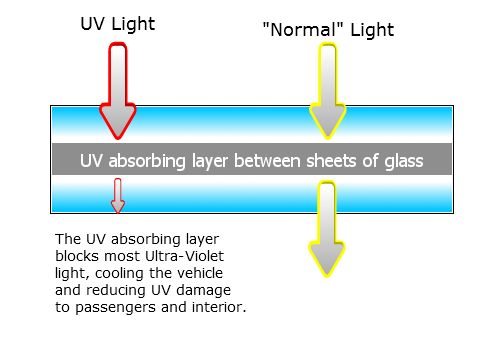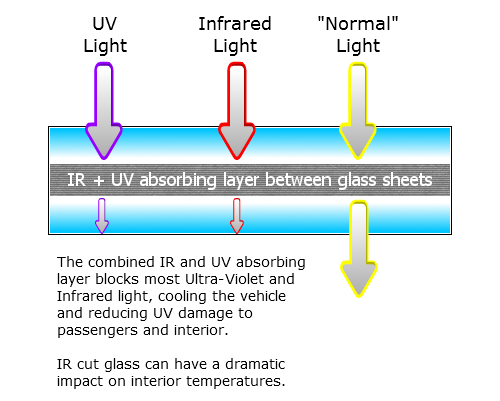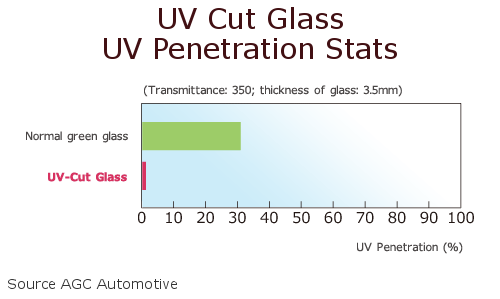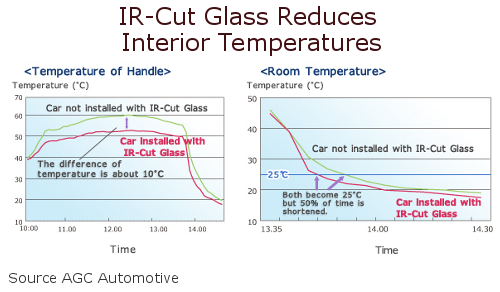A Little Bit About Automotive Glass – Truck Tech
Jason Lancaster | Oct 06, 2010 | Comments 7
Reading Toyota’s official description of the 2011 Tundra, you’ll find the following lines about glass:
Standard High Solar Energy Absorbing (HSEA) glass helps filter solar heat and most UV (skin-sensitive) light energy entering the vehicle. This reduces occupants’ sun exposure, helps to keep the interior cooler and enhances durability of interior materials. Limited grade models receive standard IR-cut glass, further reducing solar levels.
The question is, What the heck are “High Solar Energy Absorbing” glass and “IR-Cut” glass, and how do they work?
High Solar Energy Absorbing Glass
Unfortunately, we couldn’t find the exact definition of HSEA glass. However, based on some resources we found, we can infer that HSEA glass is also known as UV-cut glass. Here’s how it works:

Most solar energy is in the ultra-violet spectrum. Solar energy absorbing glass will block most ultra-violet light.
*The proportions of the glass sheets to the layer/film in the graphics here are way off – they’re just for illustration purposes.
While the graphic above shows a layer between two sheets, it’s important to recognize that glass can be “doped” with a variety of chemicals/elements to resist UV, or the glass can be coated to achieve the same effect. Zinc Oxide doped with Aluminum is a common coating for home UV absorbing glass, but doping automotive glass with Cerium and/or Neodyium and Praseodymium can achieve the same effect.
It’s likely that Toyota’s HSEA glass uses a thin film on the interior to block most of the UV.
You can see that UV-cut glass dramatically reduces the amount of UV entering the vehicle. The automotive benefits of blocking UV are numerous, including:
- Less UV radiation to heat the interior, so the A/C doesn’t have to work as hard
- Passengers are somewhat protected from UV light on skin and eyes
- Interior fabrics and materials aren’t exposed to nearly as much UV, which keeps them looking fresh and new a lot longer
IR Cut Glass

IR-cut glass blocks both UV and Infrared light, decreasing interior temperatures pretty dramatically.
IR-Cut glass is a step above UV cut (aka Solar Energy Absorbing glass) because, in addition to blocking UV, IR-cut glass also blocks infrared light. Iron is a typical additive for IR-cut glass, but obviously the specific glass additive and make-up isn’t public info.
The obvious benefit of blocking IR light is a lower average interior temperature, but it’s been estimated that IR-cut glass can also improve fuel economy, especially in hot climates. A 2001 study of a test vehicle with IR-cut glass driven in a Phoenix documented that blocking infrared light could improve fuel economy as much as 3%!
IR-cut glass is a step up from the standard HSEA glass, and on the Tundra it’s only available on the Limited model. However, IR-cut glass is yet another reason to consider a Limited Tundra: the benefits may be a slightly lower gas bill in addition to a more comfortable interior.
Aside from the Tundra limited, many Toyota vehicles have IR-cut glass. The Sequoia, many higher-end Toyota models, all hybrid vehicles, and all Lexus feature the glass, for example. Other manufacturers use IR-cut glass as well, especially on sunroofs/panoramic glass roofs.
If you can add any info to what we have here about Toyota’s HSEA or IR-cut glass, please comment below.
Filed Under: TundraHeadquarters.com




Wow… Learned something new. Very intresting.
I can wear my sunglasses at night for vision.
Mickey – Thanks! I decided to dig into this when I didn’t know what “IR cut” glass was. Still not sure about how the IR and UV are cut, but the auto glass supplier websites I found all had the same basic options – UV cut or UV/IR cut.
Any auto engineers in the know care to enlighten me?
I guess since I have a limited model I have the IR cut which gives me that extra mpg’s. No wonder why I been getting great mpg’s than most Tundra models.
Mickey – I bet it’s a fuel economy factor, especially in a Southern state like Florida.
Detail broken down nicely!
blngo